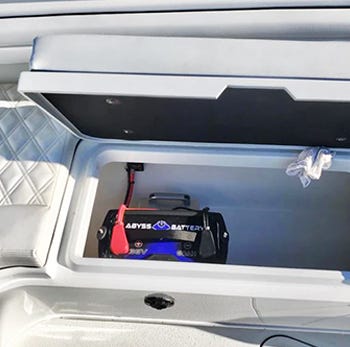

Most of the advantages of lithium batteries over lead-acid batteries for marine applications are widely known by now. This dive into the world of lithium boat batteries breaks down the perks, quirks, and everything in between, giving you the lowdown on whether it's time to switch things up for a smoother ride on the waves.
Contents
Should I Swap to Lithium Boat Batteries?
For the sake of discussion, here’s a brief summary:
- Lithium batteries can withstand far more discharge-charge cycles than lead-acid batteries. Specific claims vary widely, but it’s probably safe to say that a lithium battery is good for five to 10 times as many cycles as a lead-acid battery.
- Lithium batteries can safely be discharged by about 80 percent of their rated capacity. Lead-acid batteries can also be regularly discharged to about 50 percent without shortening their lifespan. In other words, you can use 80 amp-hours from a 100-Ah lithium battery without hurting it, but only about 50 Ah from a 100-Ah lead-acid battery.
- Lithium batteries maintain consistent voltage far longer into the discharge — until they’re around 80 percent discharged. The voltage produced by a lead-acid battery falls gradually throughout the discharge, dropping below 12V when about 35% of capacity still remains.
- The capacity of lithium batteries isn’t significantly affected by the rate of discharge. On the other hand, heavy loads actually reduce the functional capacity of lead-acid batteries.
- Lithium batteries can accept higher charging current than lead-acid batteries, so they can be recharged more quickly — in around one-fourth to one-half the time to recharge an equivalent capacity lead-acid battery.
- Partial charging doesn’t hurt lithium batteries. The lifespan of lead-acid batteries declines if they aren’t fully charged between discharges.
- Lithium batteries weigh on the order of one-fourth to one-half what a lead-acid battery with equivalent capacity weighs.
Sounds too good to be true, right? Amazingly, it isn’t. The only real downside to lithium batteries for marine use is their much higher initial cost. And that’s offset anyway by lithium’s longer service life. Still, there are a few things you should know about lithium batteries before you jump in with both feet — not disadvantages, necessarily, just considerations.
Recouping the Higher Initial Cost Takes Time
First, in weighing the initial cost of lithium versus lead-acid, it’s important to be realistic about how long you’ll keep your boat. Eventually, the higher initial cost of lithium will be offset by a longer service life.
In other words, a new lithium battery might cost three times what a new lead acid battery costs, but if it lasts four times as long, you actually save in the long run. But that’s only true if you keep the boat (and the battery) long enough to realize the savings. If you get a case of two-foot-itis every couple years, you might go the lithium route for other reasons, but don’t do it for cost savings.
Lithium Batteries Need Lithium-Specific Chargers
Second, switching from lead-acid to lithium is rarely a simple drop-in proposition. Although some newer battery chargers have both lead-acid and lithium modes, most chargers designed for lead-acid systems won’t fully charge a lithium battery, nor charge it as quickly as it can be charged.
You need a lithium-specific charging system to take full advantage of the benefits.
The bottom line is that although you usually can simply replace a lead-acid battery with a lithium battery, you need a lithium-specific charging system to take full advantage of the benefits. For many boaters, the best choice is to hire a marine electronics pro to do the job.
Weight Reduction Is Usually A Good Thing, But Not Always
Third, on some smaller boats, a dramatic reduction in battery weight can significantly affect performance — and not always for the better.
As a very general rule on boats, lighter is better; less weight means better performance, better fuel economy, shallower draft, and more weight capacity for other gear or passengers. But weight distribution is also important, and changing it can cause problems.
If your boat is already light in the bow, for instance, replacing 130 lbs. of lead-acid trolling motor batteries under the casting deck with a single 24V lithium weighing in at under 30 lbs. might make issues like porpoising worse.
Lithium Probably Isn’t Worth the Cost for Starting Batteries
Lastly, keep in mind that although lithium batteries offer tremendous advantages over lead-acid batteries when used as trolling motor batteries, house batteries or electric reel batteries, they’re less advantageous for starting applications. Dedicated cranking batteries are rarely discharged more than a few percent and are recharged by the alternator whenever the engine is running, so the ability of a lithium battery to withstand regular deep discharges and then recharge quickly isn’t much benefit.
Lithium batteries can crank engines; it’s just that they’re no better at it than lead-acid batteries. For small boats with a single battery that both cranks the engine and powers pumps, electronics, lights and audio, lithium can be a good choice, but for dedicated starting batteries, the higher initial cost of lithium just can’t be justified.

